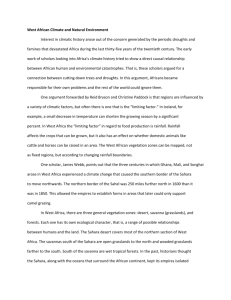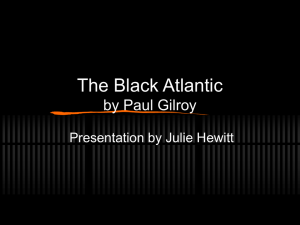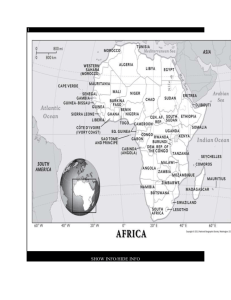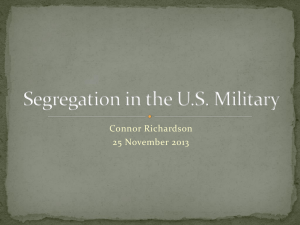Section 1 - Strongsville City Schools
advertisement
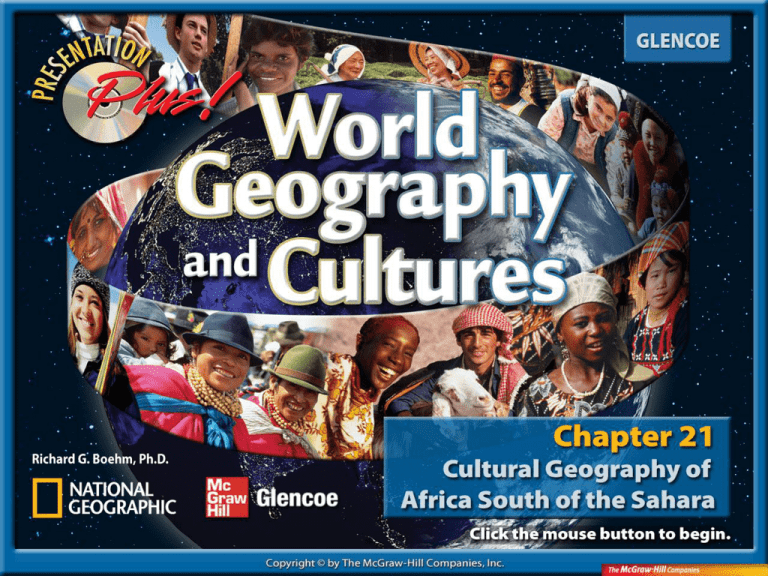
Current events in Africa south of the Sahara can best be understood by knowing about the region’s diverse peoples, its histories, and its cultures. Section 1: The Sahel Places reflect the relationship between humans and the physical environment. The Sahel, at the edge of the Sahara, influences the ways of life in this subregion. Section 2: East Africa Places reflect the relationship between humans and the physical environment. East Africa’s peoples, history, and cultures have been influenced by its location on the Atlantic coast. Section 3: West Africa The characteristics and distribution of cultures influence human systems. West Africa’s religions and social structures play a major role in people’s daily lives. Section 4: Central Africa Culture influences people’s perceptions of places and regions. While indigenous peoples built societies in response to the natural environment, European powers exploited the region. Section 5: Southern Africa Geography is used to interpret the past, understand the present, and plan for the future. Knowledge of southern Africa’s natural resources and colonial past helps one fully know the region. The Sahel The Sahel, at the edge of the Sahara, influences the ways of life in this subregion. Population Patterns The changing physical environment and the many diverse ethnic groups have shaped population patterns in the Sahel. • The people: – Mandé people of Senegal and Mali – Wolof of Senegal Population Patterns (cont.) – Hausa of Niger – Fulani – Berber Population Patterns (cont.) • Density and distribution: – Population density is unevenly distributed. – Average population density is about 103 people per square mile. – Sudan has the highest density. Muslim Population History and Government The physical environment and the relative location of the Sahel have drawn together diverse cultures that continue to influence the subregion. • First civilizations: – Egyptian civilization – The kingdom of Kush History and Government (cont.) • Empires and colonization: – The Mali Empire – Songhai Empire – Complete European control by 1914 – Colonies gained independence by 1950s African Kingdoms and Empires History and Government (cont.) • Sudan today—a division: – North—Arab-speaking Muslims; Islamicoriented government – South—live in rural areas; subsistence economy; secular government Culture Although diverse, the cultures of the Sahel region share many similarities. • The arts—African art—often expressing traditional religious beliefs—comes in many forms, from ritual masks to rhythmic drum music to folktales. • Family life—strong family ties valued. Culture (cont.) • Language—several African language groups: Afro-Asiatic, Nilo-Saharan, Congo-Kordofanian • Religion—Islam • Education—low school enrollment and literacy rates • Health care—poor health care East Africa East Africa’s peoples, history, and cultures have been influenced by its location on the Atlantic coast. Population Patterns The populations of East Africa have been shaped by their location along the long coast-line of the Indian Ocean. • In East African countries today, one ethnic group is the majority in a country. Population Patterns (cont.) • The people: – The Bantu—Uganda and Tanzania – Hutu—Rwanda and Burundi Population Patterns (cont.) • Density and distribution: – Distribution is highly uneven due to land and climate. – City dwellers, nomads, and farmers live in this region. Africa South of the Sahara: Population Density History and Government Throughout much of its history, East Africa’s location has attracted people from many continents. • Early peoples and kingdoms: – Possible place of origin for all humankind – Kingdom of Axum – Djibouti people History and Government (cont.) – Arab traders – Persians • European colonization: – Britain, France, Germany, Portugal – British doctor and missionary David Livingstone History and Government (cont.) • Colonialism created enormous problems for Africa’s people. • European powers granted colonies independence in the 1960s. • However, the newly independent countries faced (and still face) internal and external strife. Culture Common elements such as language and religion connect the cultures of East Africa. • Language—Congo-Kordofanian, Nilo-Saharan, AfroAsiatic; English and French • Religion—Christian or Muslim • Education—levels of education vary throughout the region; few complete secondary education. Culture (cont.) • Health care—many problems exist. • The arts—visual arts of masks and textiles; forms of music, dance, and oral traditions • Ways of life in East Africa are as varied as the ethnic groups who live there. West Africa West Africa’s religions and social structures play a major role in people’s daily lives. Population Patterns The location and densities of West Africa’s populations affect people’s way of life. • The people: – Hausa – Yoruba Population Patterns (cont.) • Density and distribution: – Distribution is very uneven, with most people living along the coast and river plains. – Africa’s rate of urbanization is the world’s fastest (although only 44% live in cities). Urbanization in West Africa History and Government West Africa’s history has been shaped by indigenous and outside forces, each with their own cultures. • Early empires: – Ghana Empire – Mali Empire History and Government (cont.) • The colonial era: – 1400s—Portuguese set up trading posts along the African coast. – 1600s and 1700s—Europeans were actively trading with Africans, including slaves. – French colonizers were trying to end slavery during this time as well. Culture West African culture has been shaped by hundreds of years of European and Arab influences. • Language—hundreds of languages are spoken; English, French, Arabic, Yoruba • Religion—Islam, Christianity, traditional African religions • Education—inconsistent throughout the region Culture (cont.) • Health care—uneven and limited • The arts—music and dance, weaving, masks, sculptures Central Africa While indigenous peoples built societies in response to the natural environment, European powers exploited the region. Population Patterns Groups of people throughout Central Africa usually have a shared culture, depending on where they live. • The people: – This region is home to hundreds of ethnic groups. – Most people exist by subsistence agriculture or raising cattle. Population Patterns (cont.) – Fulani – Bantu – Fang – Mbuti Population Patterns (cont.) • Density and distribution: – This region is the least densely populated on the continent. – More densely populated areas are in the Republic of the Congo, Cameroon, and the Democratic Republic of the Congo. History and Government Central Africa was the location of early migrations and, later, of European systems of slavery, colonization, and plantation economies. • Early settlement: – Bantu-speaking people established settlements in the region by A.D. 800. History and Government (cont.) • Slavery: – Huge numbers of people from the African interior were sold into slavery. The Atlantic Slave Trade History and Government (cont.) • European colonization: – It was not until the 1800s that large areas of Central Africa were colonized. – By 1960, all the French colonies had become independent countries. History and Government (cont.) • Instability after independence: – People in most Central African countries experienced periods of ethnic strife, harsh rule, and human rights abuses after independence. Culture The many diverse cultures of Central Africa share similar experiences as a result of geography, their history, and their current situation. • Language—700 local languages in the Democratic Republic of the Congo alone; French; pidgin • The arts—Mangbetu pottery, sculpture Culture (cont.) • Religion and family life are intertwined— numerous and diverse religions, but they share many common elements. • Some Christianity found as well. • Education—many systems are strained. • Health care—this is also strained in most areas. Southern Africa Understanding southern Africa’s natural resources and colonial past helps one fully know the region. Population Patterns Southern Africa is undergoing significant population changes as a result of its colonial history and present challenges. • The people: – Sena – Bantu – Swazi Population Patterns (cont.) – Zulu – San – Afrikaners Ethnic Composition of South Africa Population Patterns (cont.) • Density and distribution: – Population densities vary widely across the region. – Many people are moving to urban areas to work in gold and diamond mines. – Despite population explosions in parts of Africa, AIDS is expected to reduce the populations of many of the region’s countries. The State of HIV/AIDS History and Government Situations created by colonial rule challenge southern Africa today and will continue to do so into the future. • Early cultures: – Zulu – Bantu History and Government (cont.) • European colonization: – Arabs and Europeans settled in southern Africa for economic reasons. – The Portuguese controlled Angola, Mozambique, Comoros, and Mauritius. History and Government (cont.) • Challenges after independence: – Postcolonial rule has been a difficult adjustment for most African countries. – Exceptions—Botswana, Mauritius – Apartheid was ended in the early 1990s, but problems continue today. Culture While countries in southern Africa enjoy more freedoms under independence, they face serious economic and health-care problems. • Language—African languages; English, French, Afrikaans • Religion—Christianity as well as traditional religions Culture (cont.) • Education—since independence, higher education has expanded. • Health care—AIDS has reached epidemic proportions and most can’t afford drug treatments. • The arts—indigenous crafts, music, and dancing • Leisure—playing games and spending time with family Population Patterns • Africa south of the Sahara has the world’s highest birthrates and death rates. • The high death rate is the result of poverty, disease, and conflict. • Despite high death rates, the population of Africa south of the Sahara is growing faster than any other region of the world. Urban Growth • Although Africa south of the Sahara is one of the least urbanized regions of the world, it has the world’s fastest rate of urbanization. • Cities have better job opportunities, health care, and public services that attract people from rural areas. • Most cities in the region are built along the coast, along rivers, or in areas rich in natural resources. Almost all of the major cities began as centers of trade. Historical Legacy • In its early history, Africa was home to major trading kingdoms, like Songhai, Ghana, Mali, Kush, and Axum. • As Europeans began exploring the globe, they traded with African rulers for gold and other goods. Later they also traded for enslaved people. • The European powers later divided Africa into colonies. They extracted resources and promoted European culture at the expense of traditional African ways. indigenous native to a place domesticate to adapt plants and animals from the wild to make them useful to people oral tradition stories passed down from generation to generation by word of mouth patriarchal relating to a social group headed by a male family member clan tribal community or large group of people related to one another nuclear family family group made up of a husband, wife, and children lingua franca a common language used among people with different native languages urbanization the movement of people from rural areas into cities pidgin simplified speech used among people who speak different languages coup d′état a violent overthrow of the government apartheid policy of strict separation of the races adopted in South Africa in the 1940s
